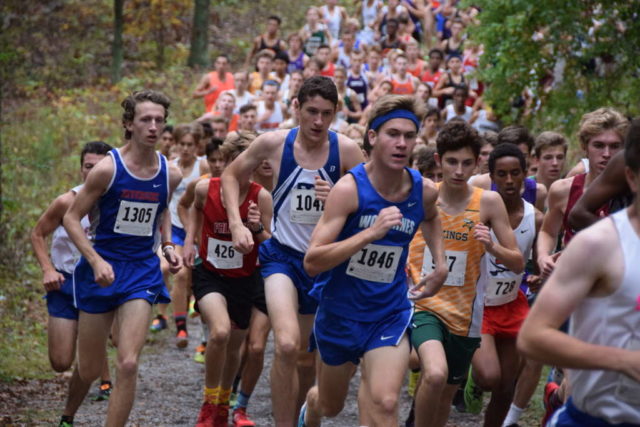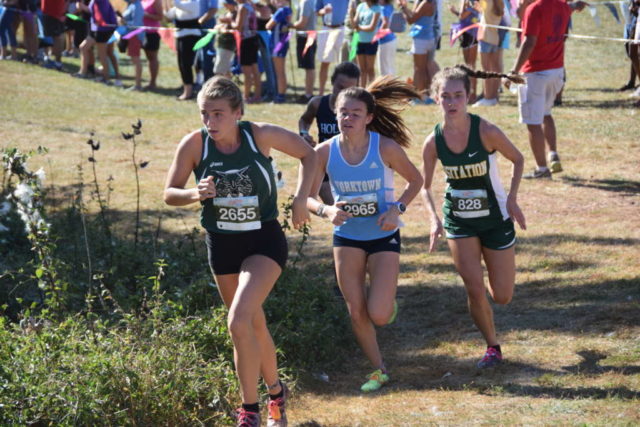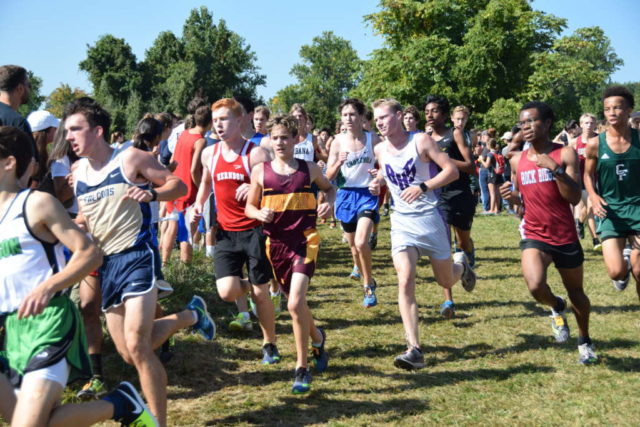
It’s 8 a.m. on a Saturday morning. Music blaring from a DJ breaks the sleepy stillness of the open field. Underneath the foggy haze of a fall morning, hundreds of high school runners are awake and ready. A mass of bodies squish together along the line, experiencing the thrill of adrenaline, nerves and anticipation.
And then the gun goes off. All you can hear is the tidal wave of cries from spectators and random cowbells clanging. The race is a blur of hills and turns and ups and downs. Sand and mud and grass.
And then it’s over. Runners stagger across the finish line; many collapse into the waiting arms of volunteers. The music is still pounding; the finish line announcer is calling out names and times. What began as a competition, intense and focused, takes on the air of a festival. Athletes wander around searching for food and friends. No longer competitors, racers from all different schools come together to hang out and enjoy the amenities.
Not just a fierce competition and not just a party, a cross country invitational is a unique hybrid of what makes the sport so wonderful. The ability to race ferociously and push past limits, but also to enjoy and embrace the running community.
At least 59 invitational meets take place in Virginia and Maryland alone during the regular high school cross country season. They range from hilly and hard terrain to flat and fast. Some meets involve as few as nine teams, while others include over 100 teams. Last year’s Oatlands Invitational, which featured 3,200 runners.
For the approximately 600 high school cross country teams in Maryland, Virginia and Washington D.C., the philosophies and plans of their coaches are just as diverse.
Coaches must whittle down the hundreds of meets available to them during the regular season to less than a dozen that fit their athletes, training plans and the constraints of the calendar. Selecting meets is a process driven by the ideology of the coach and the culture of the team.
“My number one priority is to prepare my varsity athletes for the postseason,” said Marc Hunter, head cross country coach at Loudoun Valley High School, home of the 2017 boys national cross country champions. “The glitziness and the flash [of a meet] doesn’t appeal to me unless it helps prepare my team.”
Hunter uses a five-part plan to select invitationals. First, he only brings his team to meets that are a full 5k distance and are not run on any pavement. Hunter also ensures that his athletes run multiple big races close to home so that family and friends can spectate easily. Third, Hunter wants his varsity athletes to take an overnight trip to a meet to practice adaptability before distant postseason races. His final two priorities are to select meets that are run on postseason courses and find a fast meet for his junior varsity team to end their season.
Championship meets are a critical part of any team’s planning, and coaches look to prepare their athletes for the postseason during the regular season. However, even with the same goal, coaches’ strategies on how best to prepare their athletes differ.
“In scheduling meets, a lot of weight should be on making sure athletes are fresh and the regular season doesn’t take too much out of their emotional gas tank in order for them to be physically, mentally, emotionally ready for the post season,” said Desmond Dunham, DCXC Invitational meet director and St. John’s College High School track and field head coach.
Sidwell Friends School boys cross country coach Bill Wooden also works to combat mental and physical fatigue in his athletes by mixing local meets with others along the East Coast. Ultimately, Wooden places the greatest emphasis on competing on courses that simulate postseason races.

“Our league meet is at the Agricultural History Farm Park in Derwood, Md., and it’s a challenging course,” Wooden said. “That’s an important meet so we have to run some hilly courses so that we get used to running hills. The D.C. State Championship is at Kenilworth Park, which is extremely flat, so we have to really get ready to run on a flat course.”
James Madison High School coach Craig Chasse also values running on courses that prepare his athletes for the postseason. He looks for opportunities to race at the sites of championship meets, specifically running the Monroe Parker Invitational to compete at Burke Lake Park, the location of Madison’s district and regional championship races, and competing at Great Meadow, the site of the Virginia High School League State Championship. Chasse also looks for challenging courses that may not host postseason races but will prepare his athletes nonetheless.
Matt Oblas, meet director of the Oatlands Invitational, also believes in the value of a difficult course.
“The best part of Oatlands is the course being very challenging and having a lot of diversity, from hills to creeks to wooded areas,” Oblas said. “I think the biggest thing for any meet is the course. If the course isn’t something that people want to run then all the other stuff doesn’t matter.”
Another important aspect of regular season races is having strong competition to push athletes. Chasse looks to find a balance between competing with talented Northern Virginia schools and avoiding racing the same people week after week.
“We wouldn’t want to necessarily avoid teams in our district, but we don’t want to see them seven times during the season,” Chasse said. “If we went to all the local meets, you would see all the same teams very often and it wouldn’t be as good. We travel to see how our athletes are against other people. Last year we went down to North Carolina for the Great American Invitational and there were 15 of the best 30 teams in the nation all at one meet. It was a good challenge.”
Wooden sees travelling as a way to break his athletes out of their comfort zones.
“The athletes race against people who they have no idea who they are, or how good they are, and they’re not constrained by, ‘Oh this kid always beats me so I won’t even try to beat him because I know he’s better than I am,'” Wooden said. “It’s just an opportunity for people to not have any preconceived notions and just go out there and run their own races.”
While travelling is a way for teams to face different schools and athletes, Oblas also lauded the great variety of talented teams in Northern Virginia and the D.C. area that attend local meets and create an impressive level of competition.
Hunter appreciates the opportunity to race in highly competitive meets close to home because he believes it attracts spectators and grows the sport locally.
“I want to make sure we have a couple of huge invitational races that are in our backyard, because it gives parents and friends an opportunity to see and experience a cross country race and to see their kids run in a high-level cross country race,” Hunter said.
For Walt Whitman High School cross country coach Stephen Hays, many times even the largest local meets are not big enough for his team. Hays looks for meets that do not limit the number of runners so his entire team can race.
“I like to go to meets that have a lot of races because we have a big team and I want to try to include as many people as possible in the races,” Hays said. “Some races only have a Varsity A race and a Varsity B race, so you can run 14 kids, and our team is just too big for that. I want to go to a race where they’ve got 4 or 5 races and I can race the whole team.”
As another cross country season approaches, coaches are evaluating available meets against their teams’ priorities to craft a schedule that will strengthen and prepare their teams to achieve their goals. Meet directors and teams alike will continue to work to create an environment that heightens the enjoyment of cross country.
“We try to do extra things and create the atmosphere,” Oblas said. “We try to give it character. It’s about all of those different things.”

Recent Stories
Looking for our race calendar? Click here Submit races here or shop local for running gear
Zebra Dazzle 5k Walk/Run or 100 Bike over 30 Days
Join the Zebras for this Zebra Dazzle event for all fitness levels. The 5k Walk/Run has 2 options. You can participate as an onsite participant on 9/13 at Carter Barron in Rock Creek Park, NW Washington DC or as a
Hero Dogs 5K9
Hero Dogs Inc will host its 5th Annual 5K9 race at the Congressional Cemetery on Saturday, May 17th, beginning at 8 am. There will also be a 1K Fun Run. The 1K Fun Run will start at 8 am sharp






